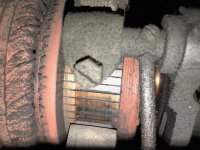hawaiianPUNCHY
Plastic
- Joined
- Oct 16, 2017
Hi,
I have a 10EE Monarch with the square dial, MG version. My lathe is smoking after it runs for about 10 min. It smells something like burning rubber. I opened all the panels and inspected all the bearings and motor housings. Everything is cool to the touch except for the commutator on the main drive motor which is rather hot. When it is running all three brushes spark. I don't know if this is normal.
I'm powering it with a 3 phase rotary converter. I originally had the converter on two 20A fuses which was ok for a couple of years. I know this machine can use a lot more than that, but I thought this was ok since I use it for small projects and don't load it with heavy cuts nor do I usually go above 1000 rpm. Recently it's been tripping the breaker. When it is hot, it would trip the breaker as soon as I reset them and engage the drive. If I let it cool down for 15 min I could run it for another 10 min until it starts tripping the breaker again. So, I upgraded my wiring and my breakers to two 30A breakers. Still less than it needs for full capacity but I think it's ok for me. Since then the breakers don't trip, but I get the smoke now.
I hope I'm not repeating issues that have been thoroughly discussed already. I've searched for this issue, and found a couple of threads, but they don't seem to match exactly my issue.
Any insight would be greatly appreciated. Thank you in advance.
I have a 10EE Monarch with the square dial, MG version. My lathe is smoking after it runs for about 10 min. It smells something like burning rubber. I opened all the panels and inspected all the bearings and motor housings. Everything is cool to the touch except for the commutator on the main drive motor which is rather hot. When it is running all three brushes spark. I don't know if this is normal.
I'm powering it with a 3 phase rotary converter. I originally had the converter on two 20A fuses which was ok for a couple of years. I know this machine can use a lot more than that, but I thought this was ok since I use it for small projects and don't load it with heavy cuts nor do I usually go above 1000 rpm. Recently it's been tripping the breaker. When it is hot, it would trip the breaker as soon as I reset them and engage the drive. If I let it cool down for 15 min I could run it for another 10 min until it starts tripping the breaker again. So, I upgraded my wiring and my breakers to two 30A breakers. Still less than it needs for full capacity but I think it's ok for me. Since then the breakers don't trip, but I get the smoke now.
I hope I'm not repeating issues that have been thoroughly discussed already. I've searched for this issue, and found a couple of threads, but they don't seem to match exactly my issue.
Any insight would be greatly appreciated. Thank you in advance.







